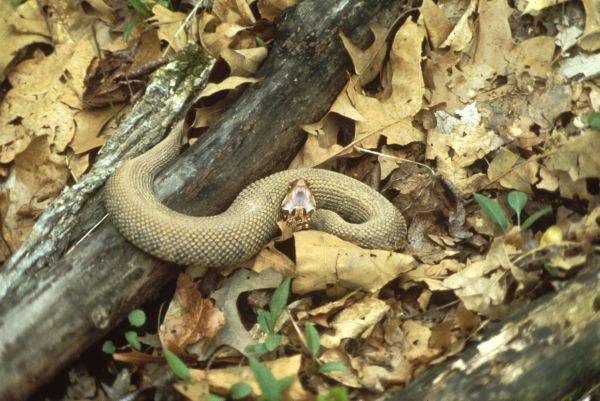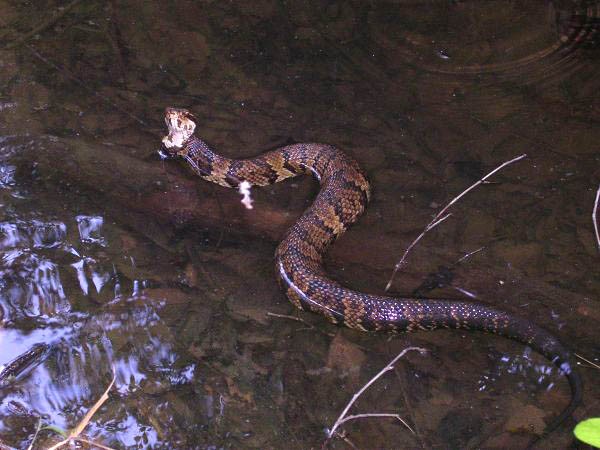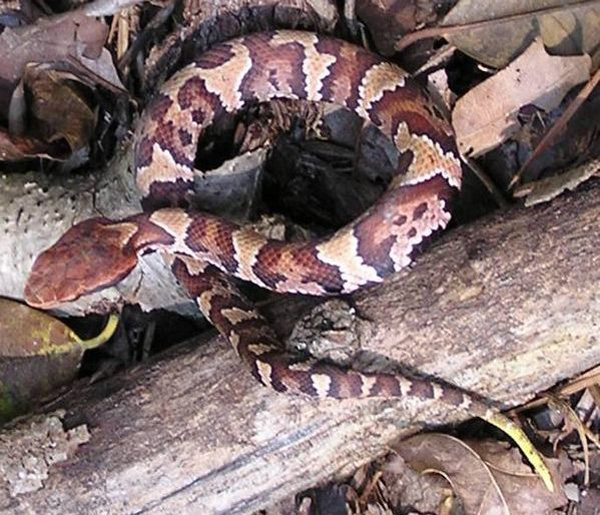Wildlife North America . com North American Animals - mamals, birds, reptiles, insects |
Eastern Cottonmouth (Agkistrodon piscivorus piscivorus)
Cottonmouth Photograph by Matthew Perry, U.S. Fish and Wildlife Service. License: Public Domain. (view image details) 
Cottonmouth Photograph by Pete Pattavina, U.S. Fish and Wildlife Service. License: Public Domain. (view image details) 
Neonate Eastern Cottonmouth: Note yellow tail tip Photograph by Cottonmouth025. License: Public Domain. (view image details)
EASTERN COTTONMOUTH FACTS
DescriptionThe Eastern Cottonmouth is the largest species of the genus Agkistrodon. The head is broad and distinct from the neck. The snout is broad. The body has a heavy build and the tail that is fairly long and slender. The background color is brown, gray, tan, yellowish olive or blackish ground color, with a series of 10-17 dark brown to almost black cross bands that are lighter on the back than the sides. The bands usually have black edges, and are sometimes broken to form staggered half bands on either side of the body. The pattern fades with age and older snakes are often uniform olive brown, grayish brown or black. The belly is white, yellowish white or tan, with dark spots, and becomes darker towards the tail. The head is a brown color, especially in A. p. piscivorus. Eastern populations have broad dark cheek stripe, bordered with pale line above and below. Young snakes have more prominent dark cross bands on a lighter background. The tip of the tail is usually yellowish, becoming greenish yellow in subadults, and black in adults. Other Names Water moccasin, black moccasin, black snake, blunt-tail moccasin Size length 80cm - 180cm Environment found near creeks, streams, marshes, swamps and the shores of ponds and lakes. Food feeds on fish, mammals, birds, amphibians, snakes, small turtles and small alligators Breeding This species is ovoviviparous. Females give birth to 6-8 young (sometimes up to 16) in August or September. Range The Eastern Cottonmouth is found in south east Virginia, eastern parts of North and South Carolina, and west across Georgia. Notes Cottonmouths get their name from the white lining of the mouth cavity. When approached they may try to escape, but will put on a threat display if confronted. They are venomous and can give a dangerous bite. Bites can cause severe bleeding and damage to tissue. If bitten, seek immediate medical attention. Young cottonmouths have fully functional fangs and are also dangerous. Classification
Relatives in same Genus Common Cantil (A. bilineatus bilineatus) Ornate Cantil (A. bilineatus taylori) Southern Copperhead (A. contortrix contortrix) Broad-banded Copperhead (A. contortrix laticinctus) Northern Copperhead (A. contortrix mokasen) Osage Copperhead (A. contortrix phaeogaster) Trans-pecos Copperhead (A. contortrix pictigaster) Florida Cottonmouth (A. piscivorus conanti) Western Cottonmouth (A. piscivorus leucostoma) Home | Mammals | Reptiles | Birds | Insects | Privacy Policy | Disclaimer | Contact Us |